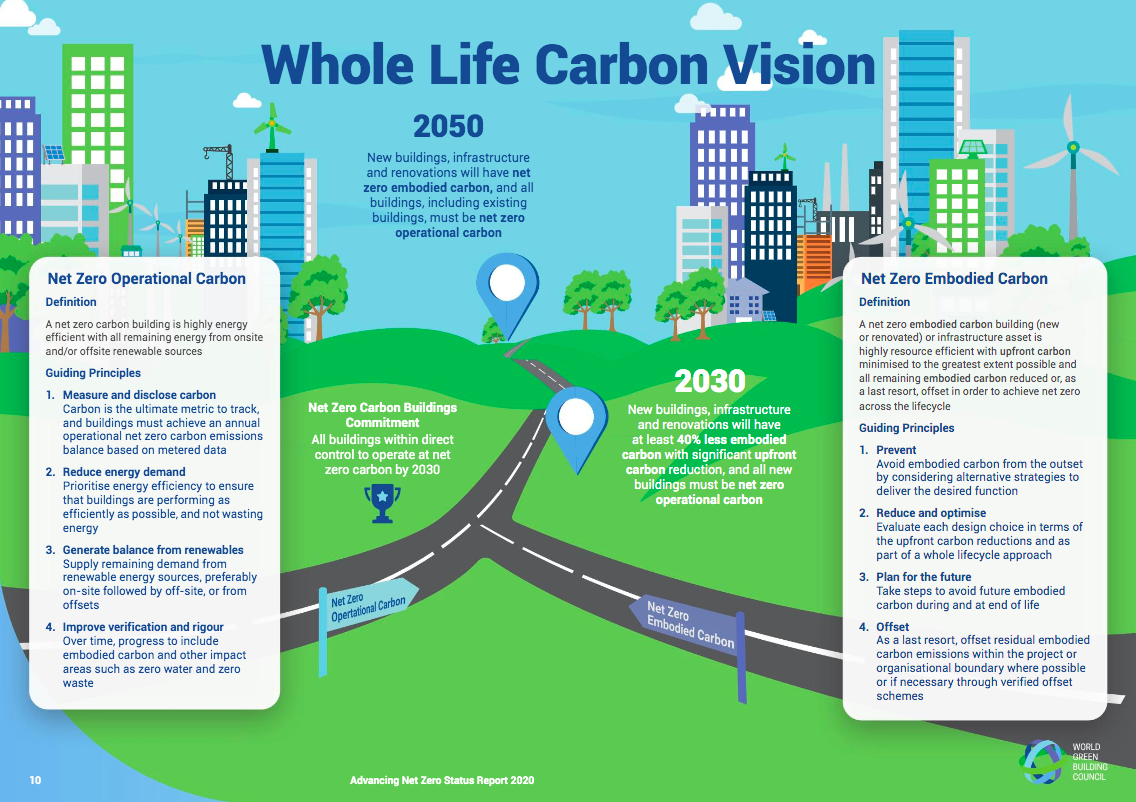Net Zero as the New Standard
Two recent signatories to the World Green Building Council's pathbreaking initiative join the organization's CEO, Cristina Gamboa, for a wide-ranging conversation.
In early June, the World Green Building Council announced that the Net Zero Carbon Buildings Commitment had gathered 96 signatories. The pledge, which aims to reach 100 percent uptake of net-zero carbon buildings by 2050, reflects a participation rate that has nearly doubled since last year.
The net-zero concept requires a shared vision across countries and industries. Of the 96 participants in the World Green Building Council’s program, 62 are businesses and organizations. Joining them are 28 cities and six states and regions.
In an exchange with CPE, WorldGBC CEO Cristina Gamboa, offered a detailed look at the initiative. Representatives of two recent signatories—Bianca Wong, global head of sustainability at building materials company Kingspan and Paul Stoller, LEED fellow & director at environmental design consulting company Atelier Ten—explain why they took the pledge.
The Commitment was launched in the fall of 2018 and now counts nearly 100 signatories. Did the Council expect this level of involvement?
Gamboa: We are very proud to have some of the world’s leading businesses, organizations, cities and states as signatories of the Commitment. In the last year alone, we’ve almost doubled the number of signatories across a range of actors in the building and construction sector. These signatories are committed to taking genuine action to reduce emissions from their portfolios.
Their leadership exemplifies market readiness for transitioning buildings to net-zero, the collective power of the public and private sectors in driving market transformation, and market willingness to deliver strategies for net-zero buildings at scale.
What made your company take the pledge?
Stoller: We committed to zero energy through the WGBC pledge because we were already committed to zero carbon and other sustainable outcomes within our own operations, and because our business is advising property clients on how to develop zero carbon buildings and landscapes. This commitment captures the essence of our daily work and our company’s mission of shaping a more sustainable world.
Wong: We’ve developed our 10-year global sustainability strategy, dubbed Planet Passionate, which is designed to impact three big global issues—climate change, circularity and protection of our natural world. The strategy is made up of 12 ambitious targets, addressing the impact of Kingspan’s business operations and manufacturing on the four key areas of energy, carbon, circularity and water. As such, we looked at partners whose mission aligns with ours, and where collaboration would strengthen our sustainability efforts.
What are the benefits of energy-efficient renovation strategies, and how can the building and construction sector implement these solutions in the market?
Gamboa: The building and construction sector is notoriously complex and fragmented, involving many different stakeholders and multifaceted challenges—this is especially true for existing buildings. Energy-efficient renovation strategies represent one of the most cost-effective solutions to tackle the climate crisis, and offer enormous potential for jobs and the economy.
READ ALSO: Building Performance Standards Are de Rigueur for the Future
The market-ready solutions could be stimulated through clear policy, regulatory certainty, financial incentives and resources, building code regulation, and increased rates of education and training. Collaboration is key to driving market transformation, supporting the transition for supply chains, and realizing the potential the built environment has for supporting health and well-being, social value and energy savings.
What will it take to turn the net-zero trend into a mainstream standard?
Gamboa: Net-zero buildings are achievable and necessary. To overcome the perceptual, technological and financial barriers to mainstreaming action, WorldGBC has developed a framework, with principles for best practices to achieve net-zero operational emissions and reduce embodied carbon. Green Building Councils around the world are developing programs and initiatives to build market capacity.
As these approaches are being successfully applied in different climates and building typologies around the world, the barriers are conquered. Regulation is the key to taking these concepts to the mainstream, and unlocking the mass uptake of net-zero.
 How can this cross-sector collaboration be accelerated?
How can this cross-sector collaboration be accelerated?
Gamboa: We must set high targets to galvanize the industry towards collective action, through key policy tools such as sector roadmaps. By setting out roadmaps at industry, regional and national levels, we can build confidence in the aligned direction of the public and private sector, stimulating innovation and creative solutions.
READ ALSO: 3 Trends Reducing the CRE Carbon Footprint
This, in turn, will create the appropriate demand-side signals to the supply chain, increasing investor confidence in capital expenditure to decarbonize supply chain processes, implement energy-efficiency improvement programs and invest in renewable energy infrastructure. Wherever you sit along the value chain, there is action you can take to trigger this acceleration to net-zero.
Has your company signed up for other green initiatives?
Stoller: Globally, we have sustainability operations plans that are developed, implemented and continuously improved by staff members in each office. We donate a portion of our profits to nonprofit organizations selected by our staff. Our staff also makes use of pro bono staff time to bring sustainability outcomes to folks who might not otherwise get them. Moreover, each office also has its own special commitments and programs. For example, here in Australia, we are developing a Reconciliation Action Plan that will help us recognize and support the Indigenous community.
Wong: In addition to our Planet Passionate program, we’ve also partnered with the Born Free Foundation, establishing a three-year partnership to support the conservation and education work of Born Free to help protect the lion population in Meru, Kenya. Kingspan is also a member of the Ellen MacArthur Foundation, which aims to accelerate the circular economy across the global construction sector. Last year, we established a three-year partnership with the ECOALF Foundation, which takes 150 metric tons of mixed waste from the Mediterranean Sea each year, to support their Upcycling the Oceans projects.
Finally, the recently opened Kingspan IKON global innovation center is focused on advanced material research and the digitalization of construction, to create solutions that address climate change, circularity, well-being and safety in buildings.
What is the impact of your organization on climate change?
Stoller: For every building we work on, we reduce energy use and drive down carbon emissions from what code allows. This adds up to many thousands of metric tons of avoided emissions. In addition, we are able to progressively reduce the embodied carbon in the building products and processes, further reducing emissions.
Beyond the buildings themselves, we also develop tools—which we share with the industry—to reduce carbon emissions in the built environment, such as the landscape Pathfinder tool, or a design methodology to optimize building system selection and operation for reduced GHG emissions, such as The Future of Carbon Neutral Design white paper.
Wong: We understand the importance of viewing buildings as holistic entities, where both the quality of construction and the quality of materials are considered carefully. As building system professionals, our focus is on optimizing the energy-efficiency performance and minimizing the environmental footprint of our products, and therefore, our buildings.
Within our own company, as part of our journey to achieve net-zero energy status, Kingspan Group has seen a 77 percent reduction in carbon intensity across its operations, and is benefiting from 34.5 GWh of energy generated on its own sites. We are 75 percent on track to net-zero energy with a 35 percent reduction in energy cost. The total projected energy savings over the lifetime of the Kingspan insulation systems, sold worldwide in 2019, is equivalent to taking 79 million cars off the road annually.
What impact will climate change have on your organization?
Stoller: Climate change will have adverse effects on our staff: stress, both physical and mental; rising sea levels forcing difficult economic and community challenges; greatly increased costs of living; and more floods and other extreme events that disrupt our lives and put us at risk. Our business is our people, so as climate change stresses us all individually, it will stress our business.
How has the COVID-19 pandemic affected the net-zero strategy?
Gamboa: We have a once-in-a-lifetime opportunity for our industry to #BuildBackBetter as part of the economic recovery. Stimulus packages must support responsible investment and development, and governments should pair recovery action with climate action to facilitate long-term and sustainable growth.
We need clear and consistent government policies that drive full decarbonization of every system of the economy: clean power, support for the renovation of existing buildings and delivery of zero-carbon infrastructure and buildings. Policies must also address how buildings can improve human health, which can help kick-start a pipeline of work and encourage job creation and re-skilling, adding millions of new quality jobs to the economy.
Renovations and retrofits account for a big part of this mission’s success, but not all renovations are performed in a sustainable or energy-efficient way. Why is this the case?
Gamboa: The renovation challenge is a systemic issue that requires a systemic solution. While the benefits of more energy-efficient buildings are well established, uptake is limited by a lack of awareness, access to finance or technical advice and unwillingness to accept the disruption of renovation works. There are also specific barriers in certain segments, such as the split-incentive problem between landlords and tenants.
READ ALSO: New-Model Ford Gets Energy Makeover
Through our work on the BUILD UPON2 project, we are tackling this problem to drive increased renovation rates and standards, starting with facilitating collaboration across all actors. This is also why we must ensure new buildings being built today are built to the highest standards possible, to reduce the need to renovate them in the near future.
 What else is slowing down renovations?
What else is slowing down renovations?
Gamboa: In the first phase of BUILD UPON2, we mapped several hundred renovation initiatives across Europe. One of the most common features we found was that they weren’t tracking their impact.
This lack of impact data is preventing policymakers from evaluating which programs work more effectively. To address this, with BUILD UPON2 we’re developing an impact framework that will give us the insight and the feedback loops we need to finally start to crack this systemic problem.
Tell us more about the upcoming World Green Building Week.
Gamboa: We’re calling on the building sector, policymakers and governments to #ActOnClimate. We’re urging them to take action to deliver net-zero buildings, which can support long-term benefits for communities, for the planet and for economies.
We know the solutions are possible. So we will use the week to showcase the existing public- and private- sector leadership, and harness our collective voice to call on policymakers for bolder and more ambitious regulation to bring the solutions to the mainstream.










You must be logged in to post a comment.